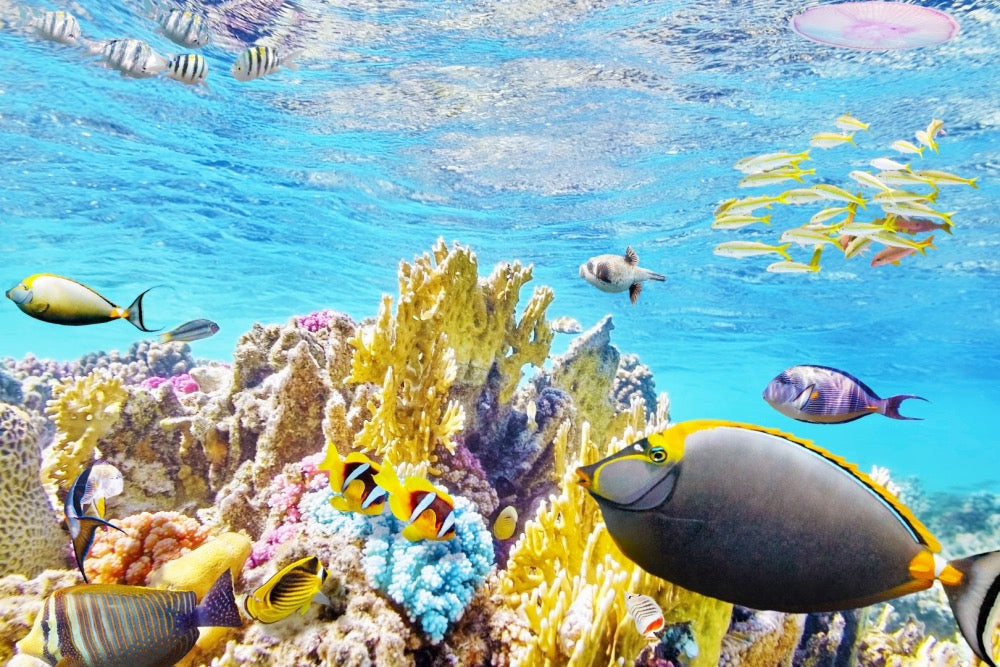The Great Barrier Reef in Australia It is a must see and one of Australia's 19 UNESCO World Heritage Sites. Australian Coral Reef tIt is also known as the Great Barrier Reef and is located in the Coral Sea off the coast of Queensland. Although it begins south of Papua Guinea, most of the Great Barrier Reef forms a parallel line on the east coast of Australia.
The Great Barrier Reef It is considered the largest in the world. With its 400 types of coral, its 1,500 species of fish and its 4,000 varieties of molluscs, the Great Barrier Reef offers a spectacle of extraordinary variety and beauty, as well as great scientific interest. Without a doubt, it is one of the great treasures of our planet, but at the same time, many are very concerned about its situation: the Great Barrier Reef is in a very serious state at the moment due to the climate crisis that our planet is suffering.
Australia's Great Barrier Reef is dying. For years now, the reef has been suffering from severe bleaching caused by rising sea temperatures, which is killing the fragile life of the corals. Now, a report commissioned by the Australian government has described the situation as "very serious": the state of the Great Barrier Reef has gone from "poor" to "very poor".
The report of the Marine Park Authority of the Great Barrier Reef, The report, published every five years, warns that the state of reefs has deteriorated, causing widespread habitat loss and degradation affecting the entire underwater world. It warns that the dire situation will not improve unless there is urgent national and global action to address the climate crisis, which it described as its greatest threat.
The report says rising sea temperatures and climate change-related extreme events such as heatwaves that caused mass coral bleaching in the northern two-thirds of the reef in 2016 and 2017 are the most immediate risks.

Other threats include agricultural pollution, coastal development and illegal fishing. The report says water quality is improving very slowly and continues to impact many coastal areas, largely due to agricultural practices that have not improved quickly enough. “Without further local, national and global action on these threats, the overall outlook for the Great Barrier Reef ecosystem will remain poor, with ongoing consequences for its heritage value,” the report says.
The Great Australian Barrier Reef It is made up of the millennia-old accumulation of coral skeletons and, on this coral structure, the largest on the planet, one of the greatest concentrations of biodiversity in the world is concentrated. It is not in vain that it is home to 400 types of coral and 1,500 species of fish and animals as special as the dugong, a peculiar marine mammal, or the green turtle, both seriously endangered. To permanently lose such a natural heritage would be irreparable.
How to protect coral reefs?
Whether you live near the coast or hundreds of miles away, there are many things you can do to keep coral reefs healthy. Many of the dangers to coral reefs occur directly in the water, but many others come from activities that take place on land, even far from shore.Ways to take care of our marine ecosystem and especially coral reefs:
- Practice safe and responsible snorkeling. Avoid touching reefs or anchoring your boat on the reef. Contact with the reef will harm delicate coral animals, and anchoring on the reef can kill corals; find a sandy bottom or use moorings if available.
- Take a reef-friendly approach when using sunscreen. Sunscreen ingredients such as oxybenzone can harm or even kill corals. Using sunscreens with titanium oxide or zinc oxide, instead of oxybenzone, are more coral-friendly options. Better yet, cut back on sunscreen use by wearing a long-sleeved shirt or wetsuit to prevent sunburn.

But it is not just a question of what we should do at sea. Our daily activity has a completely direct relationship with everything we do every day, even if we do not realize it. What things can we do every day to help in this regard and protect our environment and ecosystems?
- Recycle and dispose of trash properly. Marine debris can be harmful to coral reefs. Recycle trash (especially plastics) at home and on the go, and remember the three Rs (Reduce, Reuse and Recycle). When disposing of trash, dispose of it properly in containers to prevent it from blowing away or reaching waterways and oceans. On beaches, be sure not to leave litter behind and never throw or leave unlit cigarettes in the sand.
- Minimize fertilizer use. Overuse of fertilizers on lawns deteriorates water quality because nutrients (nitrogen and phosphorus) from the fertilizer wash into waterways and eventually end up in the oceans. These nutrients pollute the water and can harm coral reefs.
- Use environmentally friendly modes of transportation. Instead of driving a car, try walking, cycling, or using public transportation (such as buses and trains) more often. If you plan to buy a car, choose a fuel-efficient vehicle, such as a hybrid or electric car. Using these cleaner methods of transportation can help reduce the amount of greenhouse gases emitted into the atmosphere. These emissions contribute to ocean acidification and warmer oceans. Increased ocean acidity impedes coral growth, and warmer temperatures cause coral bleaching.

These are some of the measures we can take on our part to help maintain and care for all these natural treasures we have in the world. Everything under the sea is related, the animals, the plants, the water quality... And it is one of our duties to protect them! In this way, at the same time, we can continue enjoying them!
What good are ours to us? sunglasses If what we see is a destroyed planet. Take care of the planet!!

































































































